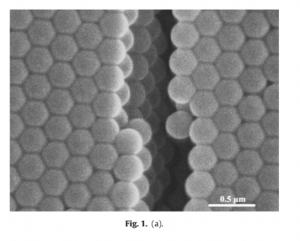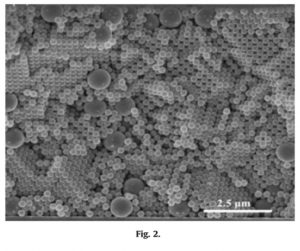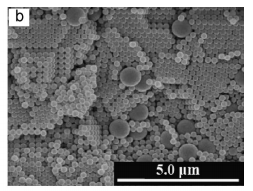Two journals published by Elsevier are retracting a pair of material science papers that appear to share figures.
The papers — in Materials Letters and Optics Communications — discuss photonic crystals, a kind of material used to manipulate light. They share the same first author, Zheng-qi Liu at Jiangxi Normal University and Nanjing University in China, as well as six other authors. Each paper presents one of the duplicated figures as a slightly different material.
One of the duplicated figures is a a picture of a photonic crystal taken with a scanning electron microscope that gives detail at the level of a few micrometers (it looks like a honeycomb, but it’s composed of tiny spheres). It’s Figure 1a in both papers:
Next up, the second duplicated figure — Figure 2b in the Materials Letters paper and Figure 2 in the Optics Communications. The picture is of a “partially disordered” photonic crystals — you can probably tell why it’s called that:
And, here’s another problem with the paper: See those larger spheres in the figure above? Each paper claims that the material in that picture has a different amount of those spheres in it.
The journals’ notes outline the specifics.
Here’s the retraction note for “Modification of spontaneous emission from fluorescent spheres by partially disordered photonic crystals,” published in Materials Letters:
The Figures 1a and 2b are the same as Figures 1a and 2 (respectively) in the paper of the same author in Optics Communications 301–302, 2013, 34–38 10.1016/j.optcom.2013.03.044 (Zheng-qi Liu, Gui-qiang Liu, Yuan-hao Chen, Kuan Huang, Xiang-nan Zhang, Zheng-jie Cai, Ying Hu). Furthermore, Fig 2 in Optics Communications and 2b in Materials Letters paper are claimed to relate to different doping levels of fluorescent spheres (2/5 in OL, and 0.05 wt% in ML) and therefore different materials.
The paper has been cited 13 times, according to Thomson Scientific’s Web of Knowledge.
And here’s the note for “Controlled disorder effect on the structure, bandgap and emission modification of three-dimensional photonic crystals,” published in Optics Communications and cited twice:
This article has been retracted at the request of the editor as the authors have self-plagiarized most part of a paper that had already appeared in in Materials Letters 101, 2013, 44-46 (10.1016/j.matlet.2013.03.069). One of the conditions of submission of a paper for publication is that authors declare explicitly that their work is original and has not appeared in a publication elsewhere. Re-use of any data should be appropriately cited. As such this article represents a severe abuse of the scientific publishing system. The scientific community takes a very strong view on this matter and apologies are offered to readers of the journal that this was not detected during the submission process.
Although the note is labeled “corrigendum,” a spokesperson from Elsevier clarified that it is a retraction:
The paper was retracted due to duplication: specifically, duplication of figures. The corrigendum was an attempt to further clarify the reason for the retraction. We are currently considering whether there might be better practical solutions for providing such clarification to the reader.
The note supplies a brief explanation as to what happened, and two different figures in place of the ones that the authors duplicated:
The author would like to apologize to the readers that Figs. 1(a) and 2 got misplaced in the original article. The correct figures are as given below.
Here are the correction figures, per the corrigendum:


We’ve also reached out to the corresponding author on both papers, Gui-qiang Liu, who works at Jiangxi Normal University, and to first author Zheng-qi Liu. We’ll update this post if we hear anything further.
Like Retraction Watch? Consider making a tax-deductible contribution to support our growth. You can also follow us on Twitter, like us on Facebook, add us to your RSS reader, and sign up on our homepage for an email every time there’s a new post. Click here to review our Comments Policy.


